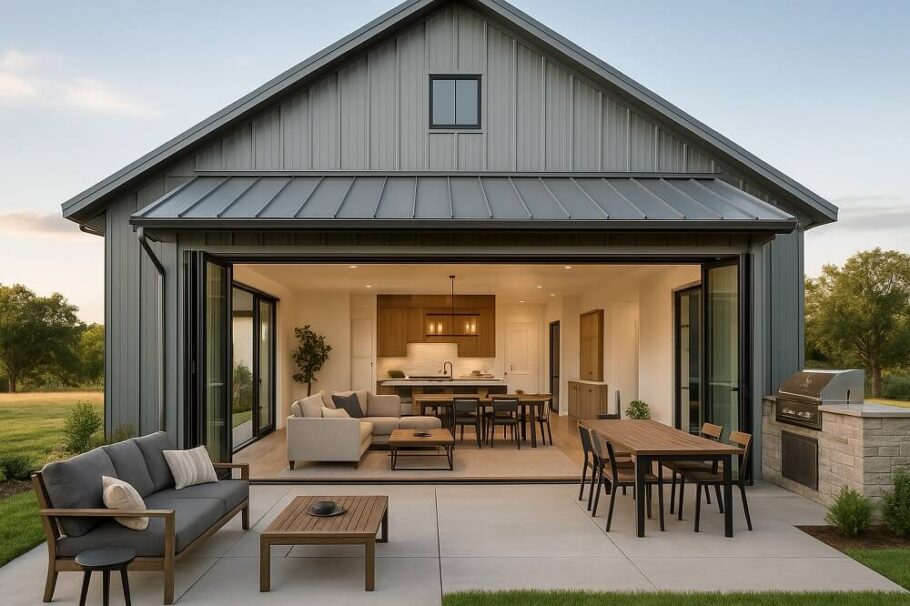For many homeowners, the barndominium represents a new phase of life—a structure that’s flexible, affordable, and filled with character. For empty nesters, those whose children have grown and moved out, a barndominium can be the perfect way to downsize without sacrificing comfort or style. This life stage often brings newfound freedom, and designing a barndominium around accessibility, hobbies, and occasional family visits allows owners to create a home that truly supports how they want to live now.
Let’s explore how an “Empty Nester Barndominium” can balance independence with comfort, ensuring it remains functional, future-ready, and welcoming for years to come.
1. Rethinking the Layout: Right-Sizing, Not Downsizing
When children move out, many homeowners find that the large family home no longer fits their lifestyle. But downsizing doesn’t always mean shrinking. It means right-sizing—designing spaces that are easier to maintain while still feeling open, airy, and comfortable.
Key design priorities:
- Single-story living: Most empty nesters prefer single-level layouts to eliminate stairs. With a barndominium’s open span structure, it’s easy to create wide, accessible floor plans without interior load-bearing walls.
- Centralized living core: Placing the kitchen, dining, and living areas at the heart of the design makes everyday life simple and social.
- Flexible guest suites: Rather than dedicating large sections to unused bedrooms, a smart design includes one or two multi-purpose guest rooms that double as hobby or office spaces when not occupied.
A 1,500–2,000 sq. ft. barndominium can feel luxurious with high ceilings, wide sightlines, and generous windows. It’s about optimizing flow and function, not square footage.
2. Designing for Accessibility: Aging in Place Gracefully
Accessibility isn’t just about ramps and handrails—it’s about designing for ease, safety, and comfort at every age. Many empty nesters build their barndominiums as their “forever homes,” so incorporating universal design principles ensures that the home remains livable through every stage of life.
Essential accessibility features:
- No-step entries and wide doors: Eliminate thresholds and use 36-inch-wide doors to accommodate mobility devices.
- Open floor transitions: Avoid carpeting or uneven flooring. Continuous surfaces like polished concrete, luxury vinyl plank, or sealed epoxy are ideal for barndos.
- Curbless showers and wider bathrooms: Wet rooms or zero-threshold showers are both functional and stylish. Add blocking in walls during framing to make future grab bar installation simple.
- Lever handles and smart lighting: Lever door handles, rocker light switches, and motion-activated lights enhance daily comfort.
- Lower kitchen counters or pull-out storage: Adjustable-height counters and deep drawers reduce bending and reaching.
Pro tip: Even if mobility isn’t an immediate concern, planning ahead during design is more cost-effective than retrofitting later.
3. A Home for Hobbies: Designing Spaces That Feed the Soul
One of the best parts of an empty nest is reclaiming time and space for personal passions. Whether it’s woodworking, gardening, painting, or car restoration, the barndominium structure lends itself perfectly to hobby integration.
Popular hobby-friendly additions:
- Attached workshop or studio: Barndominiums easily accommodate side wings or attached sheds for creative work. Large roll-up doors and tall ceilings allow for everything from pottery kilns to welding setups.
- Craft and art spaces: Natural light, durable flooring, and wall storage systems make ideal creative studios.
- Home gym or yoga retreat: With open framing, it’s easy to insulate a quiet fitness area with a polished concrete or cork floor.
- Music or media rooms: Soundproof panels and strategic insulation can transform one bay of the barndominium into a perfect listening or recording space.
- Gardening areas: Incorporate an indoor potting bench, a connected greenhouse, or easy outdoor access to raised garden beds.
These hobby zones can be visually separated from living spaces with sliding barn doors or glass partitions—maintaining privacy while keeping everything under one roof.
4. Guest-Friendly Without Feeling Empty
When family visits—especially children and grandchildren—the home should be welcoming, comfortable, and easy to navigate. But between visits, it should still feel cozy rather than cavernous.
Guest-oriented design ideas:
- Private guest wing: A small suite with its own bath gives visitors privacy while maintaining your own peace and quiet.
- Convertible spaces: A murphy bed in an office, or a loft with modular furniture, lets one room serve multiple functions.
- Outdoor guest zones: Adding RV hookups or a detached guest cabin gives family members more autonomy during longer stays.
- Kid-friendly corners: Built-in bunk alcoves or play lofts can keep grandkids entertained while preserving the adult feel of the main home.
Key insight: The goal isn’t to recreate the big family home—it’s to provide enough space for meaningful visits without overbuilding.
5. Energy Efficiency and Low Maintenance
For many empty nesters, a barndominium offers the chance to simplify life—not just by reducing square footage but also by cutting long-term maintenance and utility costs.
Smart energy-efficient upgrades include:
- Spray foam insulation or SIP panels for tight building envelopes.
- High-performance windows to maximize light while minimizing heat gain.
- Mini-split HVAC systems for zoned comfort and energy savings.
- Metal roofing and siding for durability and minimal upkeep.
- Solar readiness: Designing the roof for optimal solar panel placement can future-proof energy independence.
The combination of metal framing, low-maintenance finishes, and energy-efficient systems makes barndominiums ideal for retirees who value practicality without sacrificing design.
6. Outdoor Living: Connecting to Nature
Barndominiums often sit on generous lots—rural or semi-rural—which gives empty nesters the opportunity to connect with the outdoors.
Outdoor living features to consider:
- Covered porches and patios: Perfect for morning coffee, evening wine, or family barbecues.
- Outdoor kitchens or firepits: Encourage gatherings and extend usable living space.
- Gardens and walking paths: Gentle landscaping can be both beautiful and therapeutic.
- Pet-friendly design: Easy-clean dog washes and fenced yards simplify care for furry companions.
Large sliding glass doors or panoramic windows blur the line between inside and outside, bringing nature’s calm into daily life.
7. Personal Touches: Reflecting a New Chapter
After decades of family-centered living, empty nesters can now design a home that reflects their personal style. The barndominium aesthetic—industrial yet warm—allows for a wide range of customization.
Popular design directions:
- Rustic modern: Mix natural wood beams with sleek metal finishes.
- Industrial chic: Exposed trusses, polished concrete floors, and black-framed windows.
- Farmhouse revival: Shiplap walls, barn doors, and cozy textures for timeless appeal.
- Minimalist comfort: Clean lines, uncluttered surfaces, and smart storage for a serene feel.
Personalized details like built-in bookshelves, custom lighting, or repurposed materials from a family property can add emotional depth to the space.
8. Planning for the Future: Adaptability and Resale
While a barndominium can be a “forever home,” it’s smart to design for flexibility. Future buyers might have different needs, so layout adaptability enhances resale value.
Future-ready strategies:
- Use open spans and minimal load-bearing walls for easy remodeling.
- Add a detached garage or shop that can convert into living quarters.
- Ensure all primary living areas are accessible on the main floor.
- Keep infrastructure (plumbing, HVAC) organized for simple upgrades.
A well-engineered barndominium is not only easier to maintain—it also retains value better than traditional stick-built homes when designed with foresight.
9. Example Floor Plan: A Functional Empty Nester Layout
Approx. 1,800 sq. ft.
- Open-concept living/dining/kitchen core
- Primary suite with walk-in shower and patio access
- Guest bedroom with adjacent bath
- Hobby or office room with convertible murphy bed
- Laundry/mudroom near entry
- Covered front porch and screened back patio
- Optional attached shop or RV bay
This kind of design prioritizes flow, privacy, and usability—everything an empty nester values most.
10. The Emotional Reward: Independence with Connection
An Empty Nester Barndominium isn’t just a building—it’s a transition space between life stages. It offers freedom from excess while embracing flexibility for the future. Whether it’s tinkering in a workshop, hosting family holidays, or simply enjoying morning coffee in peace, every square foot has meaning.
Designing with accessibility, hobbies, and family in mind ensures that the home grows with you, not against you. It’s a celebration of simplicity, self-expression, and sustainability—proof that the next chapter can be your most comfortable and creative yet.
In summary:
The Empty Nester Barndominium represents the best of modern design philosophy—functional, flexible, and full of life. By integrating universal design, hobby spaces, and guest-friendly comfort, it’s possible to create a forever home that’s as practical as it is inspiring.

